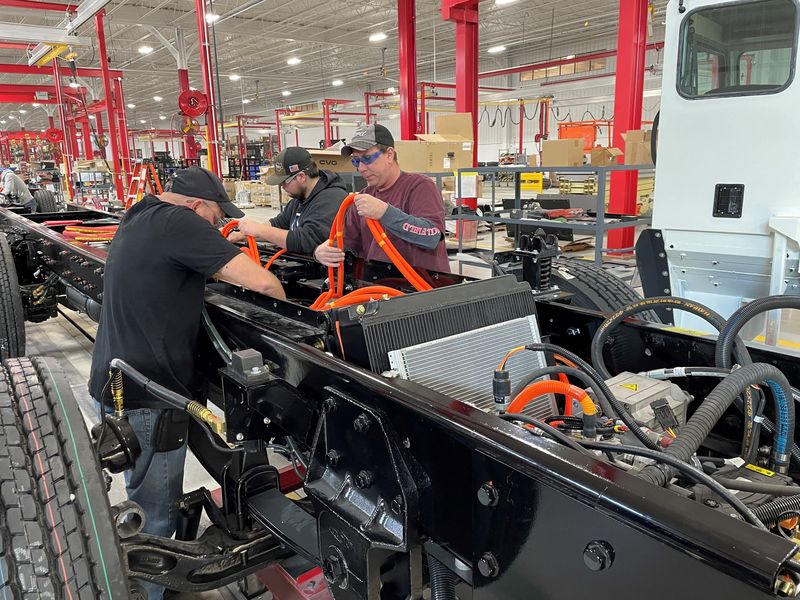
© Reuters. FILE PHOTO: Employees install cables on an electric truck as it moves down the assembly line at Battle Motors factory in New Philadelphia, Ohio, U.S., January 9, 2023. REUTERS/Timothy Aeppel/File Photo
By Lucia Mutikani
WASHINGTON (Reuters) -U.S. manufacturing slumped further in February, with a measure of factory employment falling to a seven-month low amid layoffs, but there were signs activity was on the cusp of rebounding.
The survey from the Institute for Supply Management on Friday showed customer inventories declining for a third straight month, which the ISM considered as positive for future new orders and production growth. Comments from manufacturers were also upbeat, with some saying “demand has finally picked up,” and others noting they were “experiencing increased sales.”
“We see some encouraging signs of life in manufacturing,” said Shannon Grein, an economist at Wells Fargo in Charlotte, North Carolina.
The ISM said its manufacturing PMI fell to 47.8 last month from 49.1 in January. It was the 16th straight month the PMI remained below 50, which indicates contraction in manufacturing. That is the longest such stretch since the period from August 2000 to January 2002.
Economists polled by Reuters had forecast the index edging up to 49.5. The share of PMI components with readings at or below 45, which is viewed as a good barometer of overall manufacturing weakness, was 1% last month compared to 27% and 48% in January and December respectively.
According to the ISM, a PMI reading below 42.5 over time indicates a contraction of the overall economy. That guidance has been revised down from 48.7. The economy continues to grow, expanding at a 3.2% annualized rate in the fourth quarter.
Though higher borrowing costs have cooled demand for goods and weighed on business investment on equipment, the ISM survey has painted an overly pessimistic picture of manufacturing, which accounts for 10.3% of the economy.
The Fed is expected to start cutting interest rates sometime this year. Since March 2022, the U.S. central bank has raised its policy rate by 525 basis points to the current 5.25%-5.50% range. So-called hard data from the government and Federal Reserve show manufacturing mostly treading water.
Stocks on Wall Street were trading higher. The dollar fell against a basket of currencies. U.S. Treasury prices rose. [.N] [FRX/} [US/]
UPBEAT COMMENTARY
Eight manufacturing industries reporting growth in February including apparel, leather and allied products, primary metals, chemical products and transportation equipment. Machinery, wood products, as well as computer and electronic products were among the seven industries reporting contraction.
Chemical products manufacturers said they were “currently seeing increasing sales in our business,” noting “most delivery dates are in the second quarter.” Primary metals producers reported “the month seems to be getting stronger with each passing day and week.”
While transportation equipment manufacturers said “the first quarter will be slower due to some customer order changes,” they were “expecting the rest of 2024 to be strong,” adding “we may increase our growth projections.”
But the outlook was less favorable for makers of computer and electronic products who reported “customer softness continues in China, Japan and Europe.” Harsh weather hampered operations for manufacturers of nonmetallic mineral products.
The ISM survey’s forward-looking new orders sub-index dropped to 49.2 last month after rebounding to 52.5 in January. Production at factories was subdued, with the sub-index declining to 48.4 from 50.4 in January.
Customer inventories were considered too low for a third straight month, with shortages of some goods reported. While that augurs well for future orders and production, there was a slight hint of supply chain constraints. The survey’s measure of supplier deliveries rose to 50.1 from 49.1 in the prior month. A reading above 50 indicates slower deliveries.
“For the second month, supplier responsiveness appears to be ‘stiffer,’ meaning some suppliers are struggling to keep up,” said Timothy Fiore, chair of the ISM Manufacturing Business Survey Committee.
Inflation at the factory gate remained moderate. The survey’s measure of prices paid by manufacturers slipped to 52.5 from 52.9 in January. Gradually easing price pressures were echoed by a separate survey from the University of Michigan showing consumers’ 12-month inflation expectations edged up to 3.0% in February from 2.9% in January.
It was the second straight month that inflation expectations were in the 2.3-3.0% range seen in 2018 and 2019.
“The more important news for the Fed is that there is still no sign that a material rebound in goods price inflation is in the pipeline,” said Andrew Hunter, deputy chief U.S. economist at Capital Economics.
Factory employment continued to shrink, with layoffs accounting for half of efforts by companies to reduce headcount. Manufacturers also reported hiring freezes. The survey’s measure of manufacturing employment dropped to 45.9, the lowest reading since July, from 47.1 in January.
But this measure, which has contracted for five straight months, has not been useful in predicting manufacturing payrolls in the government’s closely watched employment report. February’s employment report will be published next Friday.
Other data on Friday showed construction spending unexpectedly declining in January, but this is likely temporary amid an acute housing shortage.
Construction spending dropped 0.2% after increasing 1.1% in December, the Commerce Department’s Census Bureau said, likely reflecting harsh winter weather during the month.
“The data can be noisy from month to month and we think adverse weather may have negatively impacted the January data,” said Daniel Silver, an economist at JPMorgan in New York. “So while January showed some weakening in the trend for the construction spending data, we don’t want to take too much signal from this latest monthly print.”
Source: Investing.com





























